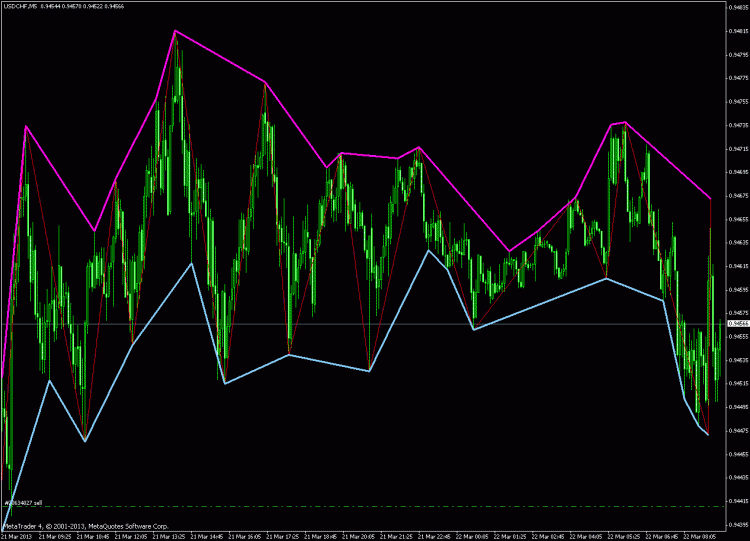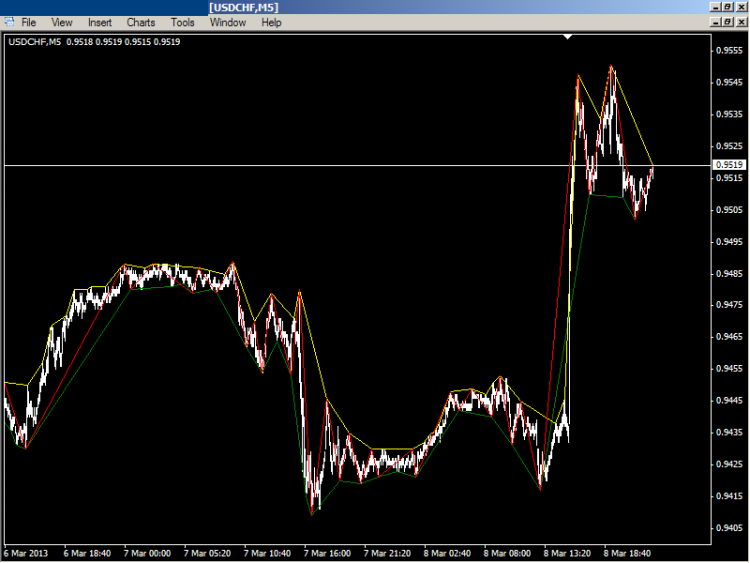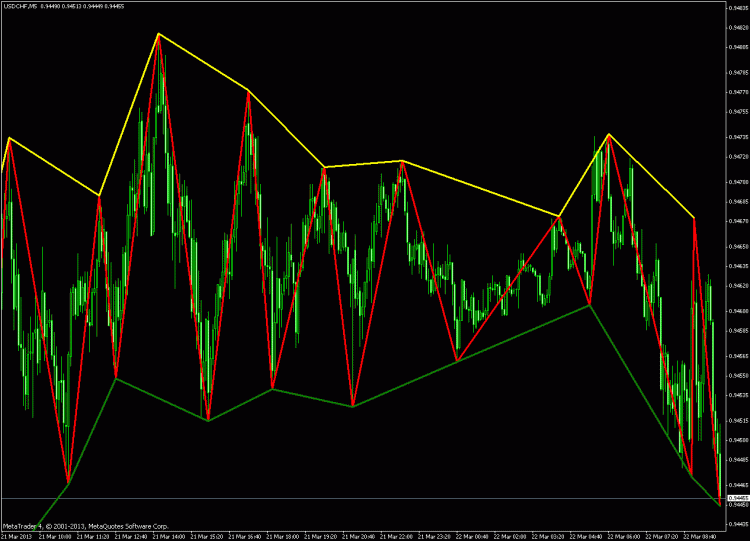比如说比较
double K = iCustom(Symbol(),0,"zigzag",ExtDepth,ExtDeviation,ExtBackstep,0,i); if (K==Low[i] && K>0) //..low zigzag......
//+------------------------------------------------------------------+ //| Zigzag2.mq4 | //| Copyright © 2005-2007, MetaQuotes Software Corp. | //| http://www.metaquotes.net/ | //+------------------------------------------------------------------+ #property copyright "Copyright © 2007, MetaQuotes Software Corp." #property link "http://www.metaquotes.net/" #property indicator_chart_window #property indicator_buffers 3 #property indicator_color1 Red #property indicator_color2 Magenta #property indicator_color3 LightSkyBlue //---- indicator parameters extern int ExtDepth=12; extern int ExtDeviation=5; extern int ExtBackstep=3; //---- indicator buffers double ZigzagBuffer[]; double HighMapBuffer[]; double LowMapBuffer[]; int level=3; // recounting's depth bool downloadhistory=false; //+------------------------------------------------------------------+ //| Custom indicator initialization function | //+------------------------------------------------------------------+ int init() { IndicatorBuffers(3); //---- drawing settings SetIndexStyle(0,DRAW_SECTION); SetIndexStyle(1,DRAW_SECTION); SetIndexStyle(2,DRAW_SECTION); //---- indicator buffers mapping SetIndexBuffer(0,ZigzagBuffer); SetIndexBuffer(1,HighMapBuffer); SetIndexBuffer(2,LowMapBuffer); SetIndexEmptyValue(0,0.0); SetIndexEmptyValue(1,0.0); SetIndexEmptyValue(2,0.0); //---- indicator short name IndicatorShortName("ZigZag("+ExtDepth+","+ExtDeviation+","+ExtBackstep+")"); //---- initialization done return(0); } //+------------------------------------------------------------------+ //| | //+------------------------------------------------------------------+ int start() { int i, counted_bars = IndicatorCounted(); int limit,counterZ,whatlookfor; int shift,back,lasthighpos,lastlowpos; double val,res; double curlow,curhigh,lasthigh,lastlow; if (counted_bars==0 && downloadhistory) // history was downloaded { ArrayInitialize(ZigzagBuffer,0.0); ArrayInitialize(HighMapBuffer,0.0); ArrayInitialize(LowMapBuffer,0.0); } if (counted_bars==0) { limit=Bars-ExtDepth; downloadhistory=true; } if (counted_bars>0) { while (counterZ<level && i<100) { res=ZigzagBuffer[i]; if (res!=0) counterZ++; i++; } i--; limit=i; if (LowMapBuffer[i]!=0) { curlow=LowMapBuffer[i]; whatlookfor=1; } else { curhigh=HighMapBuffer[i]; whatlookfor=-1; } for (i=limit-1;i>=0;i--) { ZigzagBuffer[i]=0.0; LowMapBuffer[i]=0.0; HighMapBuffer[i]=0.0; } } for(shift=limit; shift>=0; shift--) { val=Low[iLowest(NULL,0,MODE_LOW,ExtDepth,shift)]; if(val==lastlow) val=0.0; else { lastlow=val; if((Low[shift]-val)>(ExtDeviation*Point)) val=0.0; else { for(back=1; back<=ExtBackstep; back++) { res=LowMapBuffer[shift+back]; if((res!=0)&&(res>val)) LowMapBuffer[shift+back]=0.0; } } } if (Low[shift]==val) LowMapBuffer[shift]=val; else LowMapBuffer[shift]=0.0; //--- high val=High[iHighest(NULL,0,MODE_HIGH,ExtDepth,shift)]; if(val==lasthigh) val=0.0; else { lasthigh=val; if((val-High[shift])>(ExtDeviation*Point)) val=0.0; else { for(back=1; back<=ExtBackstep; back++) { res=HighMapBuffer[shift+back]; if((res!=0)&&(res<val)) HighMapBuffer[shift+back]=0.0; } } } if (High[shift]==val) HighMapBuffer[shift]=val; else HighMapBuffer[shift]=0.0; } // final cutting if (whatlookfor==0) { lastlow=0; lasthigh=0; } else { lastlow=curlow; lasthigh=curhigh; } for (shift=limit;shift>=0;shift--) { res=0.0; switch(whatlookfor) { case 0: // look for peak or lawn if (lastlow==0 && lasthigh==0) { if (HighMapBuffer[shift]!=0) { lasthigh=High[shift]; lasthighpos=shift; whatlookfor=-1; ZigzagBuffer[shift]=lasthigh; res=1; } if (LowMapBuffer[shift]!=0) { lastlow=Low[shift]; lastlowpos=shift; whatlookfor=1; ZigzagBuffer[shift]=lastlow; res=1; } } break; case 1: // look for peak if (LowMapBuffer[shift]!=0.0 && LowMapBuffer[shift]<lastlow && HighMapBuffer[shift]==0.0) { ZigzagBuffer[lastlowpos]=0.0; lastlowpos=shift; lastlow=LowMapBuffer[shift]; ZigzagBuffer[shift]=lastlow; res=1; } if (HighMapBuffer[shift]!=0.0 && LowMapBuffer[shift]==0.0) { lasthigh=HighMapBuffer[shift]; lasthighpos=shift; ZigzagBuffer[shift]=lasthigh; whatlookfor=-1; res=1; } break; case -1: // look for lawn if (HighMapBuffer[shift]!=0.0 && HighMapBuffer[shift]>lasthigh && LowMapBuffer[shift]==0.0) { ZigzagBuffer[lasthighpos]=0.0; lasthighpos=shift; lasthigh=HighMapBuffer[shift]; ZigzagBuffer[shift]=lasthigh; } if (LowMapBuffer[shift]!=0.0 && HighMapBuffer[shift]==0.0) { lastlow=LowMapBuffer[shift]; lastlowpos=shift; ZigzagBuffer[shift]=lastlow; whatlookfor=1; } break; default: return; } } return(0); } //+------------------------------------------------------------------+
可以只显示人字形的缓冲区
zigzag正在重新绘制
看看这个结果
这是我得出的结果。我还没有检查上面deVries的结果[他发帖时我正在做这个]。
#property indicator_chart_window #property indicator_buffers 2 #property indicator_color1 Green #property indicator_width1 1 #property indicator_color2 Yellow #property indicator_width2 1 double Bottoms[]; double Toppers[]; int init() { IndicatorBuffers(2); SetIndexStyle(0,DRAW_SECTION); SetIndexBuffer(0,Bottoms); SetIndexEmptyValue(0,0.0); SetIndexStyle(1,DRAW_SECTION); SetIndexBuffer(1,Toppers); SetIndexEmptyValue(1,0.0); IndicatorShortName("zz show top & bottom"); return(0); } int deinit() { return(0); } int start() { int counted_bars=IndicatorCounted(); int limit=0; limit = Bars-counted_bars; for(int shift=limit-1;shift>=0;shift--) { int ExtDepth=12; int ExtDeviation=5; int ExtBackstep=3; int ZigzagBuffer=0; int HighMapBuffer=1; int LowMapBuffer=2; Bottoms[shift]=iCustom( Symbol(),0,"ZigZag", ExtDepth, ExtDeviation, ExtBackstep, LowMapBuffer, shift ); Toppers[shift]=iCustom( Symbol(),0,"ZigZag", ExtDepth, ExtDeviation, ExtBackstep, HighMapBuffer, shift ); if(Bottoms[shift]>0.1) Bottoms[shift]=Bottoms[shift]; if(Toppers[shift]>0.1) Toppers[shift]=Toppers[shift]; } return(0); }
很好, 在你的代码的帮助下,我来到了这个......。
#property indicator_chart_window #property indicator_buffers 3 #property indicator_color1 Red #property indicator_width1 3 #property indicator_color2 Green #property indicator_width2 3 #property indicator_color3 Yellow #property indicator_width3 3 //---- indicator parameters extern int ExtDepth=12; extern int ExtDeviation=5; extern int ExtBackstep=3; double ZigZag[]; double Bottoms[]; double Toppers[]; int init() { IndicatorBuffers(3); SetIndexStyle(0,DRAW_SECTION); SetIndexBuffer(0,ZigZag); SetIndexEmptyValue(0,0.0); SetIndexStyle(1,DRAW_SECTION); SetIndexBuffer(1,Bottoms); SetIndexEmptyValue(1,0.0); SetIndexStyle(2,DRAW_SECTION); SetIndexBuffer(2,Toppers); SetIndexEmptyValue(2,0.0); IndicatorShortName("zz show top & bottom"); return(0); } int deinit() { return(0); } int start() { int counted_bars=IndicatorCounted(); int limit=0; limit = Bars-counted_bars; for(int shift=limit-1;shift>=0;shift--) { ZigZag[shift]=iCustom( Symbol(),0,"ZigZag", ExtDepth, ExtDeviation, ExtBackstep, 0, shift ); if(ZigZag[shift]>0.1 && Low[shift]==ZigZag[shift]) Bottoms[shift]=ZigZag[shift]; if(ZigZag[shift]>0.1 && High[shift]==ZigZag[shift]) Toppers[shift]=ZigZag[shift]; } return(0); }
这是给的结果
现在,底部和顶部都与 "之 "字形匹配。
deVries: 不错的ubzen,在你的代码的帮助下,我来到了这个......这就是结果
干得好,deVries。
d
deVries:
不错的ubzen,在你的代码的帮助下,我来到了这个......。这是给的结果
现在底部和顶部都与 "之 "字形匹配。
你好,deVries。
非常感谢你的代码。如果我想知道最后一条之字形腿的斐波那契回撤线与前一条之字形腿相比有多远。如何做到这一点?
我想做的是像图片一样,但下面的代码,我试图没有使它...
谢谢。
撸起袖子加油干
#property indicator_chart_window #property indicator_buffers 3 #property indicator_color1 Red #property indicator_width1 3 #property indicator_color2 Green #property indicator_width2 3 #property indicator_color3 Yellow #property indicator_width3 3 //---- indicator parameters extern int ExtDepth=12; extern int ExtDeviation=5; extern int ExtBackstep=3; double ZigZag[]; double Bottoms[]; double Toppers[]; double resBuffer[][]; //--- int init() { IndicatorBuffers(3); SetIndexStyle(0,DRAW_SECTION); SetIndexBuffer(0,ZigZag); SetIndexEmptyValue(0,0.0); SetIndexStyle(1,DRAW_SECTION); SetIndexBuffer(1,Bottoms); SetIndexEmptyValue(1,0.0); SetIndexStyle(2,DRAW_SECTION); SetIndexBuffer(2,Toppers); SetIndexEmptyValue(2,0.0); IndicatorShortName("zz show top & bottom"); return(0); } int deinit() { ObjectDelete("myFibo"); return(0); } int start() { int counted_bars=IndicatorCounted(); int limit=0; limit = Bars-counted_bars; int k=0, m=0; int candle1=0, candle2=0; double prc1=0, prc2=0; for(int shift=limit-1;shift>=0;shift--) { ZigZag[shift]=iCustom( Symbol(),0,"ZigZag", ExtDepth, ExtDeviation, ExtBackstep, 0, shift ); if(ZigZag[shift]>0.1 && Low[shift]==ZigZag[shift]) { Bottoms[shift]=ZigZag[shift]; resBuffer[k][0] = Bottoms[shift]; resBuffer[k][1] = shift; k++; } if(ZigZag[shift]>0.1 && High[shift]==ZigZag[shift]) { Toppers[shift]=ZigZag[shift]; resBuffer[k][0] = Toppers[shift]; resBuffer[k][1] = shift; k++; } } // ende for //--- for(m=k;m>=0;m--) { candle1 = resBuffer[m][1]; prc1 = resBuffer[m][0]; candle2 = resBuffer[m-1][1]; prc2 = resBuffer[m-1][0]; //--- ObjectDelete("myFibo"); ObjectCreate("myFibo", OBJ_FIBO, 0, Time[candle1], prc2, Time[candle2], prc1); } // ende for return(0); }







尊敬的各位,如何修改代码以只显示人字形的底部?